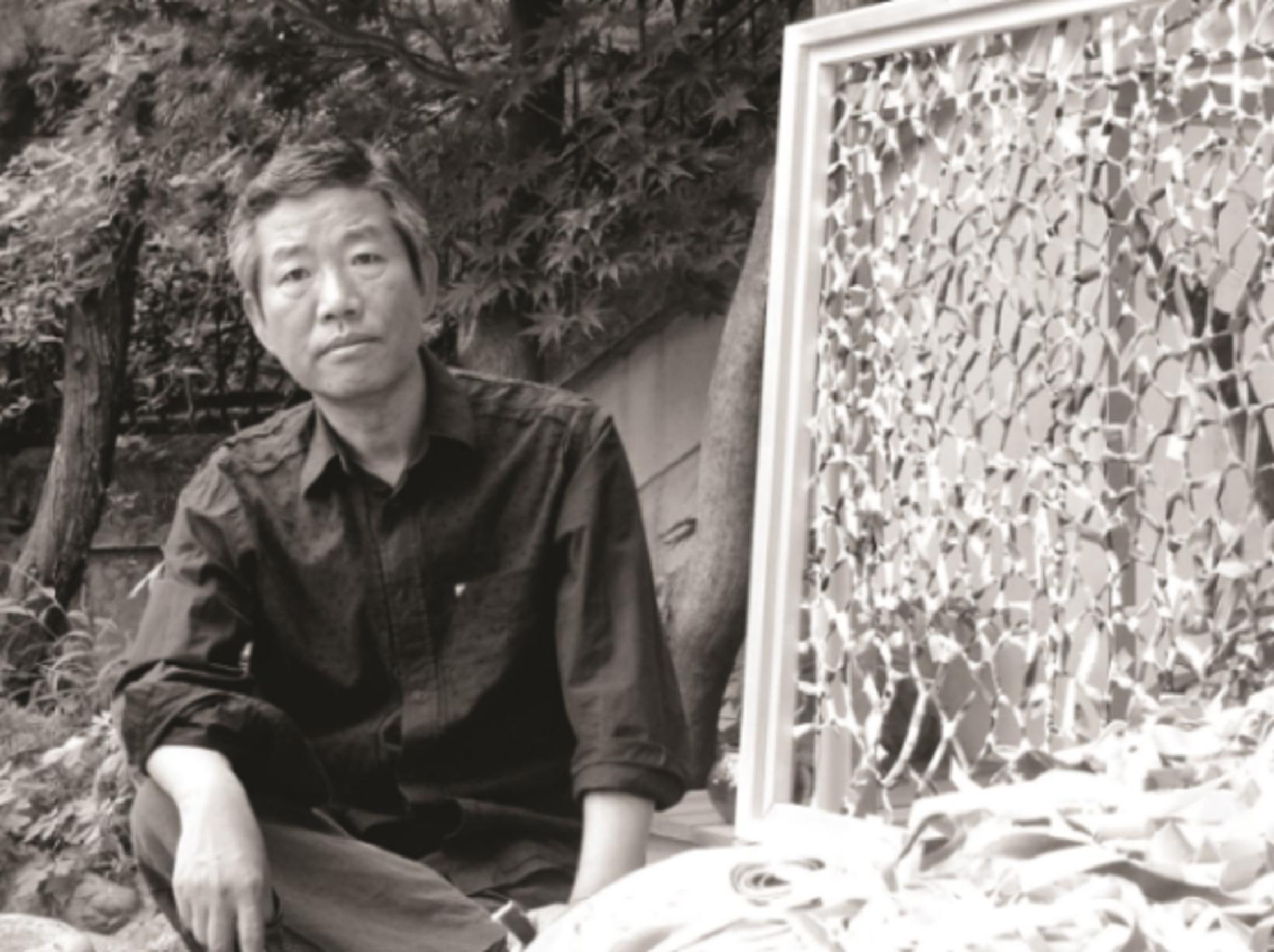Shin Sung Hy (1948–2009) majored in painting at Hongik University before leaving for Paris in 1980. Shin’s steadfast inquiry into the nature of painting is evident in his enduring experimentations with painting’s two-dimensionality and materiality. He grappled with issues such as the flatness of the canvas, the physicality of pigments, and the limitation of the canvas frame, culminating in the invention of his nouage method of weaving and knotting painted strips of canvas.
His earlier works of the mid-1970s and early 1980s used jute as the surface material of the canvas and depicted the back of the canvas in a hyper-realistic manner. These depictions of the jute itself augmented the viewer’s perception of the weave in the painting’s actual support and display the artist’s unique interpretation of the format that is painting. Eventually, his explorations resulted in the nouage technique for which he is most known. In these works, the artist coarsely painting both sides of the canvas and would rip the material into thin strips thus denying and dismantling the painted surface. By weaving and knotting the strips together, Shin reconfigured the materials into new paintings consisting of a monochromatic expanse of white with knotted colors. As a result of this technique, the weaved canvas of knots and holes become a three-dimensional relief destroying the flat surface raising the canvas itself from the background of painting to a work of art itself. In this relief, textured lines, planes and solids coexist within this pictorial sculpture or sculptural painting thus disturbing the identity of singular genres—a significant achievement of pictorial revolution.
Shin also experimented with stitched canvas works where he first painted color dots and patches on a canvas, and then cut it into pieces of a five-centimeter width each, finally stitching them together with a sewing machine. Seams are exposed and margins are coarsely cut so that the effects of lights and shades would play on them in works that also attain a relief like three-dimensionality to them.
His works are included in the National Museum of Modern and Contemporary Art, Korea, Seoul Museum of Art, Busan Museum of Art, National Foundation for Contemporary Art France, and Daegu Art Museum.
신성희(1948–2009)는 다채로운 색채와 풍부한 질감으로 회화적 맥시멀리즘을 창출한 이시대의 페인터이다. 회화적 맥시멀리즘의 표상이자 그 만의 고유 브랜드인 누아주(nouage, 엮음 회화)는 화가로서 그가 겪어온 회화적 고민과 탐구, 장고의 실험과 진통이 가져온 창조적 결실이자, 페인팅으로 페인팅을 넘어서는 새로운 개념의 회화이다.
1997년을 전후 하여 실험하기 시작한 이 누아주 작업은, 자신이 그린 캔버스를 자신의 손으로 자르고 찢는 파괴의 고통을 보상하듯, 작가에게 놀라운 미학적 발견과 창작의 희열을 주었다. 묶여진 매듭과 사이사이 구멍들로 구성된 그물망 화면은 더 이상 면이 아니라 부조적 질감을 획득하면서 선, 면, 입체가 공존하는 가운데 누아주는 회화적 조각, 또는 평면을 탈피한 조각적 회화로 존립하며 장르적 정체성을 교란시킨다. 작가는 또한 〈연속성의 마무리〉 연작을 선보이기도 하였다. 콜라주나 누아주에서와 같이 캔버스 바탕면에 색채가 베어들도록 미리 색점과 얼룩들을 그리고, 여기서는 5센티미터 정도 폭으로 잘라 봉합하듯 재봉틀로 이어 박는다. 이때 박음질 이음새를 겉으로 돌출시키고 그 시접 부분을 커터로 잘라 거친 솔기가 명암을 유발시키도록 하는데, 이와 함께 이 박음질 캔버스는 이전의 콜라주, 이후의 누아주와 같은 부조적 입체성을 획득하게 된다. 〈연속성의 마무리〉라는 연작의 제목이 암시하듯이, 이 작품군은 콜라주에서 제기된 탈회화적 시도의 연장선상에서 박음질이라는 새로운 방식으로 그러한 시도를 마무리, 완결시켰다.
이러한 노력은 신성희를 1971년 제2회 한국미술대장선에서 특별상을, 1969년 제 18회 대한민국미술전람회 특선 수상 그리고 1968년 신인예술상전에서 신인예술상을 수상하게 하였다. 2009년 10월 17일 작고하였다. 최근 신성희의 작품은 대구미술관에서 주최한 소장품 100선전을 통해 관객들을 다시 만났다.
